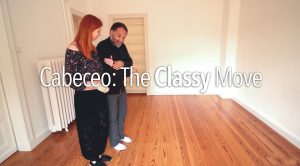The tilt or position of one’s head (for lead or follow) is far more important than you might imagine. First and foremost, where the head points the body tends to follow. There’s a reason for this, your equilibrium, contrary to popular belief your balance is not generated in the center of your belly. This ‘myth’ is better known and often repeated as to indicate your ‘core’ muscles. This is a lie. Your balance, stability, and equilibrium is generated from one place only in your body: your inner ear! And where the inner ear points….the body tends to follow suit. So in effect tilting your head to either forward, either side, or back will tend to generate a state of non-equilibrium in you, and thereby you’re now leaning, and more likely hanging on your partner in a variety of Tango moves (as a Lead OR as a Follower!).
In short, the tilt of one’s head causes an orientation issue that you want to avoid. Best practice ? Lift up your head! Pretty simple. Right ? Wrong. You’re so used to doing this that you’re not even aware that you’re doing it. For Followers the practice is to tilt their heads into their lead’s shoulder and neckline (mostly it’s a height thing). For Leads it’s watching their Follower’s feet. Neither of which is desirable.
There are two other reasons why Dancer Head Tilt is an issue, aside from the aforementioned: 1.) Physiological and Kinesthetic Body Posture. 2.) Visual alignment.
1.) One’s body posture, or just posture, is the stance that you take with your own presence on the floor and how you move, and the stance that you take with your partner. By tilting your head towards or away from your partner (either as a Lead or a Follow) you are honestly, disrupting the physiological posture that we want to generate in every move, at every point along the curve of dancing with someone. By tilting one’s head you are compromising that physiological posture!
2.) This may come as a surprise but when you tilt your head consciously, or unconsciously you are breaking the visual line that you generate with your own body. Now add in to the equation that you’re breaking the line of the couple by tilting your head and you begin to see that you have a problem. We do not want to do this in any way, shape, or form.
So in short: Lift up your head! However, as was pointed out earlier. The solution is not that simple. The reason ? Ingrained habit. You will go back to tilting your head repeatedly with every step because it’s what’s comfortable for you. Keeping you head in a floating but neutral position is difficult for someone that’s never done it before. It will seem like work at first. But once you start seeing it in your posture, and start the correction process, it will take you some time to unlearn what you have learned. Warning: Fixing this issue will create other unintended issues, you will find that your balance and stability will change as a result. You will find that your motions and vocabulary will change as a result and become seemingly more difficult for a while. The reason ? Because your center point has changed. Duh! Give it some time, it will get better.
Good luck.











